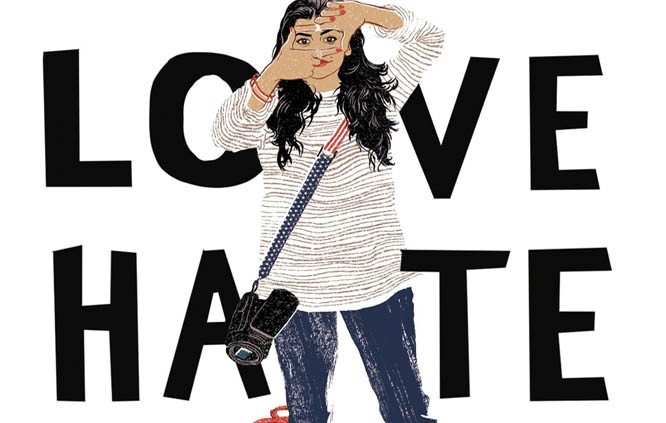
Samira Ahmed subtly builds on the crippling realities of Islamophobia, coming through with a richly layered account of life in modern-day America

The crippling realities of Islamophobia and terrorism have inspired tough, cogent writing that attempts to evoke and understand our post 9/11 world. Samira Ahmed’s Love, Hate and Other Filters builds on a similar motif in a subtle yet original manner and comes through with a richly layered account of life in modern-day America.
Although the novel fits seamlessly within the genre of young-adult fiction, it steers clear of the frivolity that many have grown to expect from books that fall within this category. Interestingly, Ahmed’s debut novel doesn’t take great pains to either separate itself from the YA genre or repeatedly emphasise its topical nature. On the contrary, the novel begins like any other book about a young girl growing up in the US.
Love, Hate and Other Filters opens a vista onto the cloistered world of Maya Aziz, a high-school student in Batavia, Illinois who has been accepted to study film at New York University (NYU). As expected, life isn’t so simple for this American-born confused desi girl. Hailing from an immigrant family of Indian origin, Maya must reckon with overprotective parents who don’t always understand her need to exercise personal choice. In order to evade any conflict with her parents, Maya skilfully shields them from those aspects of her life which they would disapprove of. Like most teenagers, she finds solace in her small rebellions and secrets. In fact, she doesn’t even tell her parents about her decision to apply to NYU. Throughout the application process, Maya’s only confidante is Hina, her unconventional aunt who has resisted the pressure to settle down and start a family.
Even though she has yet to graduate from high school, Maya’s parents are concerned about their daughter’s marriage prospects and insist on setting her up on dates with eligible men. Maya doesn’t resist her parent’s matchmaking sprees. She eventually develops an easy camaraderie with Kareem, a student at Princeton who her parents introduce her to. But Maya never seems to forget her infatuation with Phil, one of her classmates. The protagonist’s initial confusion over her feelings for both Kareem and Phil is a marker of her glaring lack of experience in handling human relationships. While some readers may criticise her for making bad decisions, their approach is likely to change as the plot reaches an unforeseen climax.
Maya is abruptly drawn into the darker realities of our times through a remote incident that hits painfully close to home. A suicide bomber who shares the same surname as her drives his truck through the doors of the Federal Building in Springfield, Illinois and detonates a bomb. The terrorist attack shatters the calm rhythm of the protagonist’s life as she becomes a victim of Islamophobia in a country she calls home. A girl whose world was once dominated by high-school crushes and the hope of attending film school in New York is thrown into a cesspool of problems that are created by other people. Amid these changing circumstances, Maya and her family are compelled to make choices that can alter their future.
With a steelier grip than most other writers, Ahmed succeeds in creating her protagonist’s sheltered world without resorting to stereotypes about the clash between eastern and western cultures. She is equally adept at depicting the quirks and insecurities of teenagers without judging them for their conduct. Even Maya’s parents have been portrayed in a realistic, humane manner that prevents them from becoming mere caricatures.
The author doesn’t try to marry the private moments of bliss in her protagonist’s life with the public turmoil that surrounds her. The chapters on Maya’s cocooned life are carefully separated from those that draw attention to the suicide bomber’s story. Maya’s world is etched for the reader through a first-person narrative whereas the suicide bomber’s motivations are put forward through concise third-person narratives. These structural choices underscore the difference between experiences that are widely known and those that need to be examined further. It is through these constantly shifting perspectives that Love, Hate and Other Filters becomes a searing indictment on America’s battle against bigotry.
Ahmed doesn’t surrender to hysteria when she tackles the sections that deal with the suicide bomber’s past. Stereotypes about Muslims haven’t been weaved into the narrative. Instead, the novel offers a nuanced portrait of terrorism. Even at a cursory level, it seems that Ahmed has done her research and, therefore, recognises that the threat of terrorism in the US is primarily domestic in nature and has more to do with perceived ideas of nationalism. The author doesn’t pull her punches and goes on to show how preconceived notions about the source of terrorism in America can have unjustified consequences. For instance, Maya’s woes could easily have been avoided if the authorities had not mistakenly identified Kamal Aziz as the bomber a few hours after the Springfield attack.
Love, Hate and Other Filters reverberates long after it’s put down because it challenges readers to confront gruesome truths about the world we live in. But even in its darker strands, the novel offers some semblance of hope in the humanity of a chaotic world.
Love, Hate and Other Filters
Author: Samira Ahmed
Publisher: Hot Key Books
Pages: 264
Price: Rs995